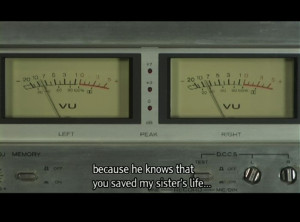In the early spring of 2009, I began working on an art project related to Jonestown together with my colleague and fiancé Valdemar Lindekrantz. The final product was a six-minute art video entitled Excavation No.1.
Excavation No.1 is the first part in a trilogy of video works that deals with American pop culture and history using different archival material found on the Internet. The title draws not only on the idea of the archeologist with an excavation site, but also of the philosopher or artist excavating an idea. We wanted the project to go beyond all the references to Jonestown that we come across as consumers of American pop culture and to dig more deeply into the tragic but also fascinating story of Jonestown. We wanted to present a story about life and death and everything in between, but we quickly learned that the latter part made it difficult to pinpoint exactly what our project would be about.
One of the Jonestown tapes – which we obtained in MP3 format through this site – helped us through our dilemma. Q 594 is a recording of a meeting between Jim Jones and the residents of Jonestown in which the community members describe what they would do to torture their enemies. Anybody could have been a potential enemy to the group, and blood ties did not matter. Mothers, fathers, and neighbors, all were included in these fantasies. I listened to the tape over and over again. It felt impossible to understand the motivations of the speakers on the tape. Why would they say such things? Did they mean it?
Six months earlier, I finished an art project about the 1999 Columbine massacre in Colorado and two school shootings in Finland that resulted in an exhibition titled, “I will be famous and at the same time I will be doomed.” In that project I was looking for a way to visually represent the public search for an answer as to why it happened, the answer that couldn’t be found. When listening to the Q 594 recording I kept coming back to the question of why. But this time it wasn’t why it happened. Instead it was, why not me? The members of Peoples Temple weren’t any different from anyone else, myself included. And yet, even after researching Jonestown through documentaries, newspapers – and even on this tape – it was difficult to imagine myself in that situation.
How can we identify with the people of Jonestown who spoke that night? Throughout our process of working with Jonestown we repeatedly experienced a dividing line between them and us. We were always looking in, observing and comparing. The challenge to overcome, or to at least question the dichotomy between Them and Us, felt important in our project about Jonestown.
 In “Excavation No.1,” we re-enacted the meeting on tape Q 594 through a transcription. Among the original transcribed confessions we added our own fantasies about taking vengeance on our family members. The audio is removed and replaced with subtitles. These subtitles work as a way to mask the identity of the people participating in the meeting, thus making it impossible to separate our confessions from the original ones. The lines between them and us are blurred for anyone not already familiar with the recording. By this we hope to challenge the separation of participation and observation and also question the division between the group and the outsiders.
In “Excavation No.1,” we re-enacted the meeting on tape Q 594 through a transcription. Among the original transcribed confessions we added our own fantasies about taking vengeance on our family members. The audio is removed and replaced with subtitles. These subtitles work as a way to mask the identity of the people participating in the meeting, thus making it impossible to separate our confessions from the original ones. The lines between them and us are blurred for anyone not already familiar with the recording. By this we hope to challenge the separation of participation and observation and also question the division between the group and the outsiders.
The lack of audio in Excavation No.1 also works as a way to disguise any emotions conveyed in the tone of the voices, making the Q 594 recording more ambiguous. The reason for this was to allow the viewer to fill the recording with her own emotions and ideas. Our aim was to open up for questions regarding what this meeting in Jonestown was really about. Was it sincere confessions with intent of murder? Or where the participants only playing along to satisfy the wants of Jim Jones? Do these fantasies act as a way of regaining a sense of control, of safety?
The number of threats posed to Jonestown and the members of Peoples Temple, real or imagined, were many. And surely Jim Jones increased that fear when he spoke of nuclear holocaust or held his White Nights.
On a personal level, I often come back to a very sadreflection when watching Excavation No.1 or listening to the original Q 594 recording, that these confessions, as horrible and emotionally disturbing as they might seem, are in their essence very tragic considering the outcome for almost everyone, if not everyone, on that tape. They may speak of killing others, but it is their own lives they end up taking.
(Nicola Bergström Hansen and Valdemar Lindekrantz are artists living and working in Stockholm, Sweden. Nicola Bergström Hansen is 27 years old and is starting her first year of a masters in fine arts at Konstfack Stockholm. She can be reached at nicolabergstrom@gmail.com. Valdemar Lindekrantz is 23 and starting his final year at the School of Photography, Gothenburg, leading to a bachelor of photography.
(Excavation No.1 has been shown at Åmåls Konsthall and Mariestads Konsthall, both in Sweden.)